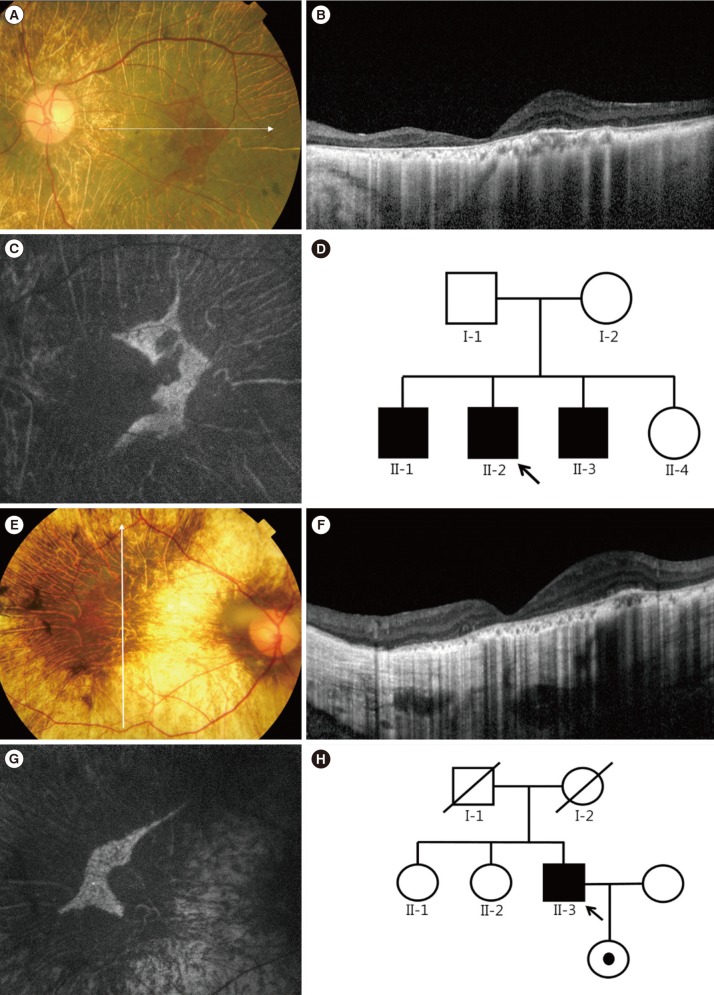Ann Lab Med.
2017 Sep;37(5):438-442. 10.3343/alm.2017.37.5.438.
Identification of Pathogenic Variants in the CHM Gene in Two Korean Patients With Choroideremia
- Affiliations
-
- 1Department of Ophthalmology, Samsung Medical Center, Sungkyunkwan University School of Medicine, Seoul, Korea. sangjinkim@skku.edu
- 2Department of Laboratory Medicine and Genetics, Samsung Medical Center, Sungkyunkwan University School of Medicine, Seoul, Korea. changski@skku.edu
- 3Samsung Genome Institute, Samsung Medical Center, Sungkyunkwan University School of Medicine, Seoul, Korea.
- 4Department of Health Sciences and Technology, SAIHST, Sungkyunkwan University, Seoul, Korea.
- 5Department of Molecular Cell Biology, Sungkyunkwan University School of Medicine, Seoul, Korea.
- 6Department of Neurology, Samsung Medical Center, Sungkyunkwan University School of Medicine, Seoul, Korea.
- KMID: 2383921
- DOI: http://doi.org/10.3343/alm.2017.37.5.438
Abstract
- Choroideremia is a rare X-linked disorder causing progressive chorioretinal atrophy. Affected patients develop night blindness with progressive peripheral vision loss and eventual blindness. Herein, we report two Korean families with choroideremia. Multimodal imaging studies showed that the probands had progressive loss of visual field with characteristic chorioretinal atrophy, while electroretinography demonstrated nearly extinguished cone and rod responses compatible with choroideremia. Sanger sequencing of all coding exons and flanking intronic regions of the CHM gene revealed a novel small deletion at a splice site (c.184_189+3delTACCAGGTA) in one patient and a deletion of the entire exon 9 in the other. This is the first report on a molecular genetic diagnosis of choroideremia in Korean individuals. Molecular diagnosis of choroideremia should be widely adopted for proper diagnosis and the development of new treatment modalities including gene therapy.
Keyword
MeSH Terms
Figure
Reference
-
1. Rafuse EV, McCulloch C. Choroideremia. A pathological report. Can J Ophthalmol. 1968; 3:347–352. PMID: 5727760.2. Rubin ML, Fishman RS, McKay RA. Choroideremia. Study of a family and literature review. Arch Ophthalmol. 1966; 76:563–574. PMID: 5928144.3. MacDonald IM, Hume S, Chan S, Seabra MC. Choroideremia. In : Pragon RA, Adam MP, Ardinger HH, Wallace SE, Amemiya A, Bean LJH, editors. GeneReviews [Internet]. Seattle, WA: University of Washington;1993-2015.4. Roberts MF, Fishman GA, Roberts DK, Heckenlively JR, Weleber RG, Anderson RJ, et al. Retrospective, longitudinal, and cross sectional study of visual acuity impairment in choroideraemia. Br J Ophthalmol. 2002; 86:658–662. PMID: 12034689.5. MacDonald IM, Chen MH, Addison DJ, Mielke BW, Nesslinger NJ. Histopathology of the retinal pigment epithelium of a female carrier of choroideremia. Can J Ophthalmol. 1997; 32:329–333. PMID: 9276121.6. Seabra MC, Brown MS, Slaughter CA, Südhof TC, Goldstein JL. Purification of component A of Rab geranylgeranyl transferase: possible identity with the choroideremia gene product. Cell. 1992; 70:1049–1057. PMID: 1525821.7. van den Hurk JA, Schwartz M, van Bokhoven H, van de Pol TJ, Bogerd L, Pinckers AJ, et al. Molecular basis of choroideremia (CHM): mutations involving the Rab escort protein-1 (REP-1) gene. Hum Mutat. 1997; 9:110–117. PMID: 9067750.8. Pfeffer SR. Rab GTPases: master regulators of membrane trafficking. Curr Opin Cell Biol. 1994; 6:522–526. PMID: 7986528.9. Sanchez-Alcudia R, Garcia-Hoyos M, Lopez-Martinez MA, Sanchez-Bolivar N, Zurita O, Gimenez A, et al. A comprehensive analysis of choroideremia: From genetic characterization to clinical practice. PLoS One. 2016; 11:e0151943. PMID: 27070432.10. Sergeev YV, Smaoui N, Sui R, Stiles D, Gordiyenko N, Strunnikova N, et al. The functional effect of pathogenic mutations in Rab escort protein 1. Mutat Res. 2009; 665:44–50. PMID: 19427510.11. O SJ, Kim SH, Lee HY. A case of choroideremia with recurrent anterior uveitis. Korean J Ophthalmol. 2003; 17:55–62. PMID: 12882509.12. Lee CY, Shin TY. Choroideremia. J Korean Ophthalmol Soc. 1981; 22:433–438.13. Korea National Research Institute of Health. Korean Reference Genome Database (KRGDB). Accessed on May 2016. http://152.99.75.168/KRGDB.14. Exome Aggregation Consortium (ExAC). Accessed on May 2016. http://exac.broadinstitute.org.15. Richards S, Aziz N, Bale S, Bick D, Das S, Gastier-Foster J, et al. Standards and guidelines for the interpretation of sequence variants: a joint consensus recommendation of the American College of Medical Genetics and Genomics and the Association for Molecular Pathology. Genet Med. 2015; 17:405–424. PMID: 25741868.16. Ramsden SC, O'Grady A, Fletcher T, O'Sullivan J, Hart-Holden N, Barton SJ, et al. A clinical molecular genetic service for United Kingdom families with choroideraemia. Eur J Med Genet. 2013; 56:432–438. PMID: 23811034.17. Shimizu K, Oishi A, Oishi M, Ogino K, Morooka S, Sugahara M, et al. Next-Generation Sequencing-based molecular diagnosis of choroideremia. Case Rep Ophthalmol. 2015; 6:246–250. PMID: 26327910.18. Li S, Guan L, Fang S, Jiang H, Xiao X, Yang J, et al. Exome sequencing reveals CHM mutations in six families with atypical choroideremia initially diagnosed as retinitis pigmentosa. Int J Mol Med. 2014; 34:573–577. PMID: 24913019.19. Furgoch MJ, Mewes-Arès J, Radziwon A, Macdonald IM. Molecular genetic diagnostic techniques in choroideremia. Mol Vis. 2014; 20:535–544. PMID: 24791138.
- Full Text Links
- Actions
-
Cited
- CITED
-
- Close
- Share
- Similar articles
-
- Clinical and Genetic Findings in Korean Patients with Choroideremia
- Choroideremia
- A Case of Choroideremia with Recurrent Anterior Uveitis
- Clinical Manifestations and Genetic Analysis of 5 Korean Choroideremia Patients Initially Diagnosed With Retinitis Pigmentosa
- Clinical Validity of Next-Generation Sequencing Multi-Gene Panel Testing for Detecting Pathogenic Variants in Patients With Hereditary Breast-Ovarian Cancer Syndrome



